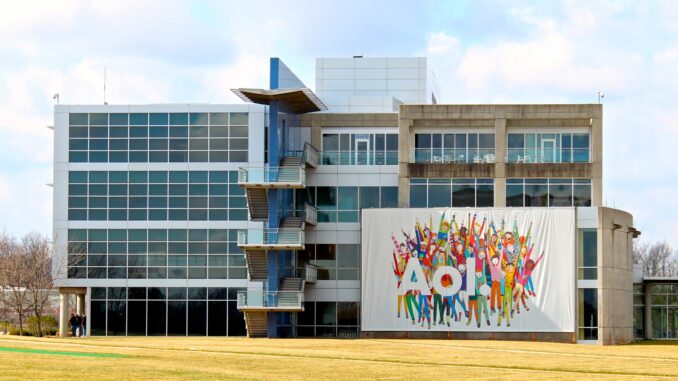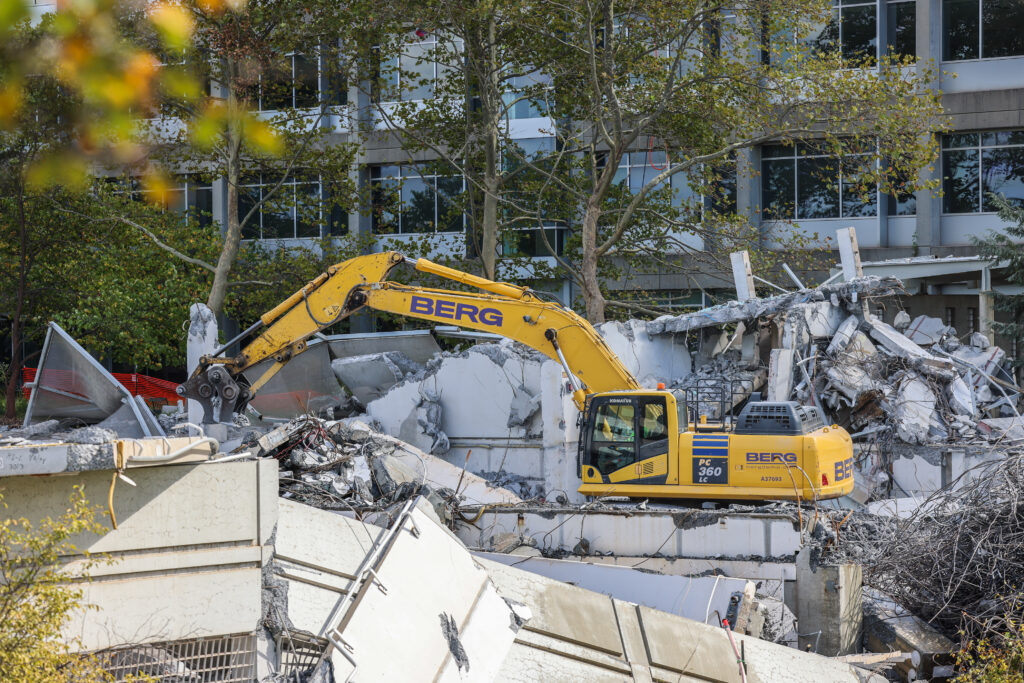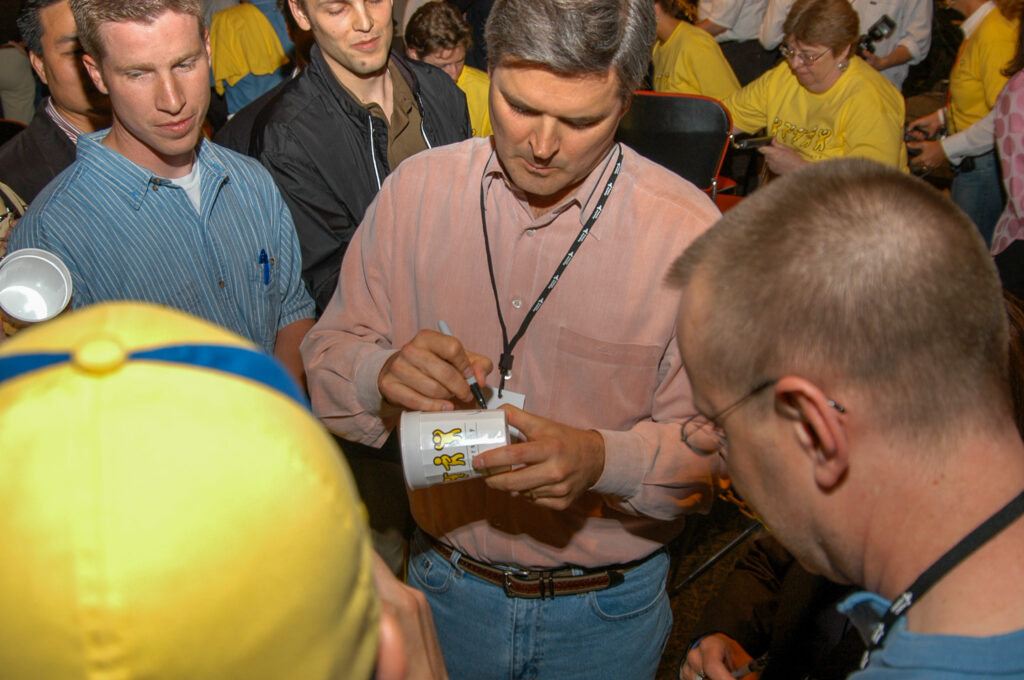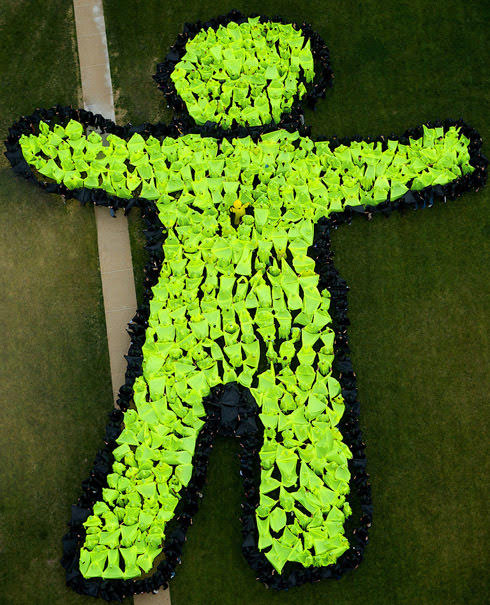
THE LEGACY OF AOL
By Jonathan Hunley
For Steve Gaitten, it all started with some tears.
In 1996, America Online announced that it would move its headquarters from Tysons to the former British Aerospace building, just east of the Broad Run creek that often acts as the border between Ashburn and Sterling.
Gaitten, an AOL employee, was one of the first to drive to the new site to take a look. He wasn’t impressed. Once he passed Reston, all he could see were cedar trees and open farmland. He pulled over, put his face in his hands and wept. His office would soon be in the middle of nowhere.
But that, of course, didn’t last.
“I could never imagine what it’s become today,” said Gaitten, who now lives in Round Hill and runs a digital marketing company.
Back then, few could have envisioned the bustling suburban community that is Ashburn and Sterling and Dulles and beyond. Neighborhoods as far as the eye can see. Office buildings. Shopping centers. Restaurants and stores. High-end car dealerships. Heck, there are even a couple of Metrorail stops.
And the data centers. The old chestnut that a majority of the world’s online traffic flows through the area each day is true.
And all this happened – in large part – because America Online came to town.
END OF AN ERA
The campus that was America Online – now commonly known as just AOL – is kitty-corner across Waxpool Road from the Wegmans grocery store and Target department store where many Ashburn residents shop.

Currently, the abandoned campus is being demolished, making way for even more data centers. The insides of the buildings that once made up the company’s headquarters have been stripped, and heavy equipment like backhoes and bulldozers are methodically tearing down the structures and reducing them to rubble.
Although AOL’s footprint in Loudoun may soon be erased, the company’s legacy and impact on the community – and especially Ashburn – live on.
“It’s really hard to tell the story of Loudoun’s success without talking about AOL,” said Buddy Rizer, executive director of Loudoun County’s Department of Economic Development.
Rizer says when AOL arrived in Ashburn, the company basically was the internet because everyone used its dial-up connections to get online. The internet service provider’s email notification, “You’ve got mail,” was so much a part of the culture that it inspired a hit movie with those three words as the title.
AOL would go on to employ about 5,300 workers in Ashburn at its largest point, in 2004. Many of them lived in Ashburn, creating a population of wealthy, educated, tech-savvy residents who made the area a coveted place to live and a new hub for the rising digital world.

After AOL moved to Loudoun, something called the Metropolitan Area Exchange, East, a major internet exchange or traffic hub, was moved from Tysons and Reston to be closer to AOL. That eventually led to the area’s so-called “Data Center Alley,” which is the world’s largest cluster of data centers, totaling 31 million square feet spread over roughly 165 buildings.
“Every technology company wanted to be connected to that [exchange],” Rizer said. “So they started laying miles and miles of fiber in the ground that benefited everything that came after. It was a domino effect – with all the other companies and technologies that have followed.”
That domino effect continues right into the pocketbooks of Ashburn residents today. That’s because data centers – for all the grumbling about them – account for about three-quarters of a billion dollars in tax revenue each year, or a third of the county’s overall budget. Over the past 15 years, according to estimates, these new technology companies have helped the county lower the real estate tax rate by 40 cents per $100 of assessed value.
“What started with AOL became an economic success story unlike anything seen before – we became a place that technology workers and technology companies wanted to relocate to,” Rizer said. “Sure, there were the soft benefits of bringing in highly educated people. But there were hard benefits, too, such as billions spent on roads, attracting the Metro, building 31 new schools and lowering the tax rates. Those are significant things that really started with the arrival of AOL in the late 1990s.”
But alas, all good things must come to an end. AOL moved its headquarters to New York in 2007. Today, the brand is owned largely by private equity firm Apollo Global Management and falls under the Yahoo umbrella of companies.
Needless to say, AOL is nowhere near as popular as it used to be. Among Millennials and Gen Z, saying you once used AOL to access the internet is tantamount to saying you’re a senior citizen.
But despite its fall from the pinnacle of the tech world, the AOL website and smartphone apps still exist and include news stories, weather information and email.
GOOD TIMES, GREAT MEMORIES
“Nothing changed Loudoun County more than AOL did,” said former employee Jim Simpson.
Simpson, who lives in Centreville, is one of the many workers who still rave about their time with the company. He joined AOL in 1994, starting on the call center floor at the Tysons location, and found himself being promoted. He eventually left in 2002.
Like Gaitten, Simpson remembers that there was little in the area when AOL came to town. “It was empty,” Simpson said. “There was nothing out there.”
Brian Corcoran, today a business consultant and fractional CFO for small companies in Richmond, recalls lots of open fields and sod farms. There was a Walmart and a Best Products department store – and that was it. He lived 3 miles from the office, and the commute took only 3½ minutes. He says the same commute today would take at least 15 minutes.
But he and Simpson say AOL was a fun, exciting place to work. “There were so many new technologies coming out,” Simpson said.

Corcoran was a payroll manager when AOL brought its headquarters to the area. He says the company paid its employees well and offered great benefits, such as stock options. And the company was hiring as many people as possible, which meant there was little in the way of red tape.
“We were growing so fast we didn’t have time for bureaucracy,” Corcoran said.
The company was growing fast because its subscriber base was increasing. Parties were thrown every time it passed a benchmark number of customers: 1 million, 5 million, 10 million. “We celebrated every milestone,” he said.
There was a lot of work to be done, however. Employees sometimes logged 60- or 70-hour weeks.
“I slept there many weekends,” said Eddie McGlamery, an Ashburn resident who started at AOL in 1997 as a temporary worker and ended up staying for 11 years.
Workers also became lifelong friends because they spent so much time together. Many employees didn’t mind working late because the company often provided food and other perks for them. And then there were the parties – some of which are legendary among the old guard.
One time, executives rented out the entire National Air and Space Museum’s Udvar-Hazy Center. A conveyor belt was set up around an airplane. In the middle was a sushi chef who put his creations on the belt for distribution to the partygoers.

The grandeur of the event “was just beyond comprehension,” said Carleigh Gavin. The 39-year-old, who lives in Ashburn, started working for AOL in 2006, following in the footsteps of her mother, who also worked at the company. Believe it or not, Gavin still (sort of) works there today – employed by the AOL’s now-parent company, Yahoo.
At another Christmas gathering, Corcoran recalls go-go-style dancers who were painted gold and gyrating in what looked like human-sized bird cages. And another time, the company rented out Union Station in Washington for a soirée.
ALL GOOD THINGS…
But the work environment changed after AOL agreed to merge with Time Warner in 2000, said Alex Korab, a photo editor at the time.
“I started right as the merger was happening,” Korab said. “It was very interesting – AOL merging with this giant of traditional media. There was a lot of friction.”
The merger was one of the largest in American history, but it has also been called one of the worst. In 2010, the New York Times published a story about it under the headline, “How the AOL-Time Warner Merger Went So Wrong.”
Korab describes it as the free-wheeling culture of a tech start-up running up against a more formal, old-school company.
“It was a little like the Wild West before – just do whatever you want – and now there were new rules and policies. And there was resistance from the AOL’ers,” she said.
Today, Korab is co-owner of Transition Tri Sports in Leesburg. She recalls one other very personal way she was able to measure the impact AOL had locally – skyrocketing home values. She paid $165,000 for a townhouse in Ashburn when she went to work for AOL in 2000 and sold it five years later for $400,000.
The residential and commercial development “happened really fast,” Korab said.
Just because the campus of AOL’s former Loudoun County home is being razed doesn’t mean this historic spot will fade away. The 43-acre property was sold for $136 million in December 2021.
According to a report from Data Center Dynamics, a new data center complex called PowerHouse Pacific will be built on the site.
Demolition of the AOL buildings should wrap up early next year, including the removal of two parking garages, three office buildings and an old pedestrian bridge across Pacific Boulevard. This work will be followed by construction of a new power substation. Then work on the first of three PowerHouse Pacific buildings is scheduled to start next fall with completion expected in 2026.

For Steve Gaitten – who shed tears when he first saw the rural, isolated landscape that would become AOL and his future home – looking back brings a mixture of pride and some bitterness.
“I ended up writing an email to a couple of friends about what I found [while scouting the new AOL location],” Gaitten said. “I had a line in there – ‘I can see a future where all the broken-down pickups are replaced with Porsches.’ And it was prophetic. AOL fulfilled the dream of growth for an area that was amazingly undeveloped just 30 miles west of the capital of the free world.”
Gaitten said he remains proud of the fact that more than 70% of the world’s internet traffic goes through the area.
“But at the same time, there is a tinge of sadness,” he added. “AOL was such a great company. We were so far ahead of our times that you felt like you were living five years in the future. We were using text messaging and video chats that you knew would be mainstream in a matter of years. But the missed opportunity. AOL should have gone on to become Facebook. It should have been Google, not been replaced by Google. I think it’s a tragic business story – like Kodak – it just missed the market. I have a little bit of sadness about that.”
Jonathan Hunley is a career journalist and lifelong Virginian who has written for publications around the state.
(Image at top: Courtesy of Loudoun County Department of Economic Development)

Everything said about AOL in the article is certainly true. What needs greater understanding and context is what’s happening to Loudoun County because of the data centers. These monstrous, cement slab-sided boxes are destroying the character of Loudoun and the reason so many people moved here. These data centers, many of which are around 1 million SqFt, employee maybe 15-20 people each. They do nothing whatsoever to improve the surrounding area – no increase in visits to restaurants for breakfast, lunch, dinner. No uptick in shopping at local stores. Sure they generate -temporary- construction jobs – for people that live in West Virginia and western Virginia. Now I’m not anti-data center – I enjoy all the benefits of the Internet and modern technology. But these facilities should be located in industrial parks, not near homes and not along every stretch of prime commercial real estate in eastern Loudoun (like along Rt28 and now Rt7). Buddy Rizer should be driven out of town on rails (a very different perspective from what I know he believes). Its his job to attract businesses and bring a complement of benefits to the area, not simply additional sale tax revenue. Sure the tax rates have gone down, but that doesnt mean you dole-out all the prime real estate to the easy option. Its hard work to attract actually businesses that want to operate out of office buildings – but thats Rizers job! Its not like if a data center was denied being built on a prime parcel of commercial real estate, that nothing else would ever be built there. It might take longer but there will eventually be a suitable option that again, brings a breadth of benefits to the surrounding area.